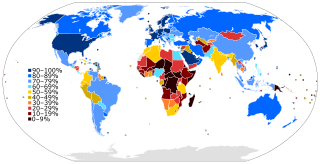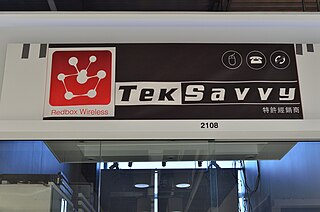Related Research Articles

The Canadian Radio-television and Telecommunications Commission is a public organization in Canada with mandate as a regulatory agency for broadcasting and telecommunications. It was created in 1976 when it took over responsibility for regulating telecommunication carriers. Prior to 1976, it was known as the Canadian Radio and Television Commission, which was established in 1968 by the Parliament of Canada to replace the Board of Broadcast Governors. Its headquarters is located in the Central Building of Les Terrasses de la Chaudière in Gatineau, Quebec.

An Internet service provider (ISP) is an organization that provides services for accessing, using, managing, or participating in the Internet. ISPs can be organized in various forms, such as commercial, community-owned, non-profit, or otherwise privately owned.

In telecommunications, broadband is the wide-bandwidth data transmission that transports multiple signals at a wide range of frequencies and Internet traffic types, which enables messages to be sent simultaneously and is used in fast internet connections. The medium can be coaxial cable, optical fiber, wireless Internet (radio), twisted pair, or satellite.
Traffic shaping is a bandwidth management technique used on computer networks which delays some or all datagrams to bring them into compliance with a desired traffic profile. Traffic shaping is used to optimize or guarantee performance, improve latency, or increase usable bandwidth for some kinds of packets by delaying other kinds. It is often confused with traffic policing, the distinct but related practice of packet dropping and packet marking.
Telkom SA SOC Limited is a South African wireline and wireless telecommunications provider, operating in more than 38 countries across the African continent. Telkom is majority state-owned (55.3%) with the South African government owning 40.5% of Telkom, while another 14.8% is owned by another state-owned company - the Public Investment Corporation (PIC), which is closely linked to the South African government.

Internet Protocol television (IPTV) is the delivery of television content over Internet Protocol (IP) networks. This is in contrast to delivery through traditional terrestrial, satellite, and cable television formats. Unlike downloaded media, IPTV offers the ability to stream the source media continuously. As a result, a client media player can begin playing the content almost immediately. This is known as streaming media.

Network neutrality, often referred to as net neutrality, is the principle that Internet service providers (ISPs) must treat all Internet communications equally, offering users and online content providers consistent rates irrespective of content, website, platform, application, type of equipment, source address, destination address, or method of communication.

Plusnet plc is a British triple play internet service provider (ISP) providing broadband, landline and mobile services. The company was founded in 1997 in Sheffield, England, and became a public limited company (plc) in July 2004 when it was floated on the Alternative Investment Market. On 30 January 2007, Plusnet was acquired by BT Group, but it continues to operate as a separate business. By December 2013, it had over 750,000 customers across the UK.
Bandwidth throttling consists in the intentional limitation of the communication speed, of the ingoing (received) or outgoing (sent) data in a network node or in a network device.
A data cap, often erroneously referred to as a bandwidth cap, is an artificial restriction imposed on the transfer of data over a network. In particular, it refers to policies imposed by an internet service provider in order to limit customers' usage of their services; typically, exceeding a data cap would require the subscriber to pay additional fees based on whether they have exceeded this limit. Implementation of a data cap is sometimes termed a fair access policy, fair usage policy, or usage-based billing by ISPs.

The Internet in Africa is limited by a lower penetration rate when compared to the rest of the world. Measurable parameters such as the number of ISP subscriptions, overall number of hosts, IXP-traffic, and overall available bandwidth are indicators that Africa is far behind the "digital divide". Moreover, Africa itself exhibits an inner digital divide, with most Internet activity and infrastructure concentrated in South Africa, Morocco, Egypt as well as smaller economies like Mauritius and Seychelles. In general, only 24.4% of the African population have access to the Internet, as of 2018. Only 0.4% of the African population has a fixed-broadband subscription. The majority of internet users use it through mobile broadband.

Canada ranks as the 21st in the world for Internet usage with 31.77 million users as of July 2016 (est), making up 89.8% of the population. According to Harvard researchers, Canada has some of the lowest internet standards among OECD countries, as a result of high costs and slow internet speeds.

SSi Canada is a Canadian wireless broadband internet service provider primarily serving remote areas that lack terrestrial service options. SSi was established in 1990 by Jeffrey Philipp and is headquartered in Yellowknife, capital of the Northwest Territories. SSi is also a provider of Satellite Communication services, offered in locations that do not have terrestrial service options. They offer turnkey Internet systems to other ISPs. They have a local market serving all 25 communities in Nunavut and several in the Northwest Territories. These two territories account for 1/3 of Canada's landmass covering 3,439,296 km2 (1,327,920 sq mi). They also have an international market including Africa, Indonesia and Kiribati.
Net neutrality in Canada is a debated issue, but not to the degree of partisanship in other nations, such as the United States, in part because of its federal regulatory structure and pre-existing supportive laws that were enacted decades before the debate arose. In Canada, Internet service providers (ISPs) generally provide Internet service in a neutral manner. Some notable incidents otherwise have included Bell Canada's throttling of certain protocols and Telus's censorship of a specific website critical of the company.
Comwave Networks Inc. is a Canadian company that markets telecommunication services. Actual telecommunication services are provided by third party carriers. Based in the Toronto district of North York and run by president and CEO, Yuval Barzakay, Comwave was established in 1999 and it serves all of Canada. Wholesale services are also provided in the United States.

TekSavvy Solutions Inc. (TSI) is a Canadian residential, business, and wholesale telecommunications company based in Chatham, Ontario. In most of the country, it is a wholesale-network-access-based service provider and voice reseller, connecting its service to existing last mile networks from telecom carriers Bell Canada and Telus Communications, and cable carriers Rogers Communications, Cogeco Cable, Shaw and Vidéotron. However, in parts of rural southwestern Ontario, the service is provided over TekSavvy's own fixed wireless network. Recently they have also rolled out their own fibre optic network in parts of southwestern Ontario.
The Competitive Network Operators of Canada (CNOC) (French: Opérateurs de Réseaux Concurrentiels Canadiens (ORCC)) is an organisation of over 30 independent Canadian telecommunications providers. It often lobbies to the CRTC and other regulatory bodies to represent the interest of its members in matter of high-speed Internet accessibility, VoIP industry regulations, anti-monopoly market competitiveness, and privacy of customer information. CNOC's current president and chairman is Paul Andersen, also President of Egate Networks.
Internet bottlenecks are places in telecommunication networks in which internet service providers (ISPs), or naturally occurring high use of the network, slow or alter the network speed of the users and/or content producers using that network. A bottleneck is a more general term for a system that has been reduced or slowed due to limited resources or components. The bottleneck occurs in a network when there are too many users attempting to access a specific resource. Internet bottlenecks provide artificial and natural network choke points to inhibit certain sets of users from overloading the entire network by consuming too much bandwidth. Theoretically, this will lead users and content producers through alternative paths to accomplish their goals while limiting the network load at any one time. Alternatively, internet bottlenecks have been seen as a way for ISPs to take advantage of their dominant market-power increasing rates for content providers to push past bottlenecks. The United States Federal Communications Commission (FCC) has created regulations stipulating that artificial bottlenecks are in direct opposition to a free and open Internet.
Net bias is the counter-principle to net neutrality, which indicates differentiation or discrimination of price and the quality of content or applications on the Internet by ISPs. Similar terms include data discrimination, digital redlining, and network management.

The digital divide in Canada refers to the discrepancy that exists between Canadians who have access to information and communication technologies (ICT) and the benefits they provide compared to those who do not. This divide can be the result of many factors, including high costs for technology and online access, differences in the availability of online connectivity resources in different locations across the country, and lacking digital literacy. The digital divide in Canada also stems from income inequality among Canadians and differences in online practices exhibited by those of different age, gender, first language, and cultural background.
References
- ↑ Genealogy of Konrad Graf Finck von Finckenstein
- ↑ Raycraft, Richard (29 December 2022). "Sidney Crosby, Eugene Levy and Karina LeBlanc among 99 new Order of Canada appointees". CBC News . Retrieved 29 December 2022.
- ↑ "Order of Canada appointees – December 2022". Governor General of Canada. 29 December 2022. Archived from the original on 29 December 2022. Retrieved 29 December 2022.
- ↑ "Evidence - CHPC (39-1) - No. 39 - House of Commons of Canada".
- ↑ "$6.7 Million in Fines Paid by Jungbunzlauer International A.G. and Haarmann & Reimer Corporation for Violations of the Competition Act". Archived from the original on 2013-01-01. Retrieved 2012-01-23.
- ↑ "BMG Canada Inc. v. John Doe, 2004 FC 488, [2004] 3 F.C.R. 241".
- ↑ "CRTC extends exemption for new media and calls for a national digital strategy". Archived from the original on 2011-12-22. Retrieved 2012-01-23.
- ↑ "CCRTC requires Internet service providers to be more transparent about their Internet traffic management practices". Archived from the original on 2011-12-10. Retrieved 2012-01-23.
- ↑ "CRTC takes action to ensure a wide choice of television programming on all platforms". Archived from the original on 2012-01-07. Retrieved 2012-01-23.
- ↑ "CRTC supports choice of Internet services". Archived from the original on 2012-01-19. Retrieved 2012-01-23.
- ↑ "Statement from the Chairman of the CRTC on usage-based billing". Archived from the original on 2011-02-06. Retrieved 2011-02-04.